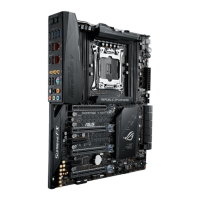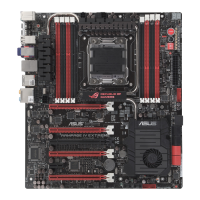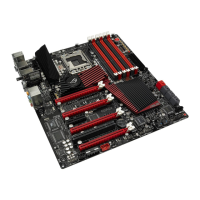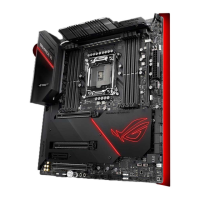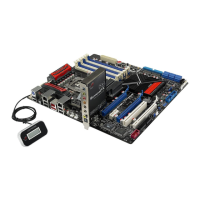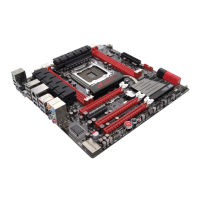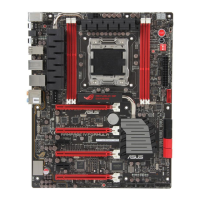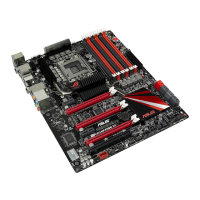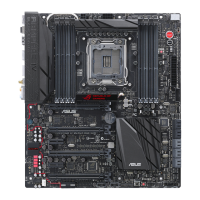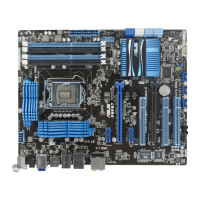
Do you have a question about the Asus Rampage V Extreme and is the answer not in the manual?
| Chipset | Intel X99 |
|---|---|
| CPU Socket | LGA 2011-v3 |
| Memory Type | DDR4 |
| Memory Slots | 8 |
| Max Memory Supported | 64GB |
| Form Factor | Extended ATX |
| M.2 Socket 3 | 1 |
| PCIe 3.0 x16 Slots | 5 |
| PCIe 2.0 x1 Slots | 1 |
| USB 3.1 Ports | 2 |
| USB 2.0 Ports | 6 |
| RAID Support | RAID 0, 1, 5, 10 |
| Memory Speed | DDR4 3300(O.C.)/3200(O.C.)/3000(O.C.)/2800(O.C.)/2666(O.C.)/2400(O.C.)/2133 MHz |
| LAN | Intel I218V, 1 x Gigabit LAN Controller(s) |
| Audio | ROG SupremeFX 8-Channel High Definition Audio CODEC |
| Multi-GPU Support | 4-Way NVIDIA® SLI™ & AMD CrossFireX™ |
Key features of the motherboard and its supported technologies.
Key features of the motherboard and its supported technologies.
Description of ROG-exclusive audio technology and gaming software.
Details on specific ROG features like Extreme Engine Digi+ IV and iROG.
Overview of ASUS exclusive utilities like AI Suite 3 and USB BIOS Flashback.
Information on bundled software including Kaspersky, DAEMON Tools, and DTS Connect.
Detailed overview of the motherboard's components and layout.
Essential precautions to take before installing motherboard components.
Diagram and identification of motherboard connectors and jumpers.
Explanation of onboard buttons for system control and fine-tuning.
Description of onboard LEDs for BIOS activity and PCIe lane indication.
Step-by-step guide for installing the motherboard into the PC chassis.
Step-by-step guide for installing the motherboard into the PC chassis.
Instructions for correctly installing the CPU into the LGA2011-v3 socket.
Procedure for installing the CPU heatsink and fan assembly.
Guide on how to install DDR4 memory modules into the DIMM slots.
Steps for connecting the ATX power supply to the motherboard.
Instructions for connecting SATA hard disk drives.
Details on connecting front panel connectors like USB and audio.
Guide for installing PCIe x16 and PCIe x1 expansion cards.
Steps for installing the dual band Wi-Fi antenna.
Information on updating the BIOS using USB BIOS Flashback.
Identification and description of rear panel connectors.
Identification and description of rear panel connectors.
Introduction to the OC Panel device and its components.
Introduction to the OC Panel device and its components.
Guide on installing the OC Panel in a 5.25-inch drive bay.
Initial steps for powering on the system for the first time.
Explanation of the UEFI BIOS interface and its purpose.
Accessing and navigating the BIOS setup program.
Overview of the EZ Mode interface for basic system information.
Accessing and navigating the Advanced Mode for detailed BIOS settings.
How to save and access frequently-used BIOS items.
Overview of basic system information and security settings.
Changing system security settings, including BIOS passwords.
Configuring overclocking-related items and system performance.
Changing settings for the CPU and other system devices.
Settings related to CPU features, power management, and virtualization.
Configuring PCI Express slots and speeds.
Settings for managing USB-related features and ports.
Configuration of power management settings like ErP Ready and Wake-on-LAN.
Settings for enabling or disabling the UEFI network stack.
Options to enable or disable onboard LEDs and ROG logo LED.
Displays system temperature, power status, and fan settings.
Configuring system boot options and device priority.
Accessing special functions like GPU Post and BIOS utilities.
Options to load defaults, save, or discard BIOS changes.
Procedures for updating the motherboard BIOS.
Procedure for updating the BIOS using a USB flash drive.
Information on supported OS versions for the motherboard.
Instructions to launch the support DVD and its main menu.
Instructions to launch the support DVD and its main menu.
Overview of the AI Suite 3 interface and its integrated utilities.
Combines TPU, EPU, DIGI+ Power Control, Fan Xpert 3, and Turbo App.
Dynamically optimizes PC performance based on real-time usage.
Manually adjust CPU frequency, cache, core frequencies, and voltages.
Customizable settings for CPU and chassis fans for optimal cooling.
Technology to automatically speed up USB storage device transfer rates.
Displays detailed information about installed motherboard, CPU, and memory.
Connect to wireless networks and set up a computer as an access point.
Utilities for PC control from smart devices, including file management.
Enhancements for motherboard audio features.
Audio suite offering reverb, bass boost, equalizer, and virtual surround.
Automatically detects headphone impedance and adjusts AMP levels.
Enhances in-game audio for better directional awareness.
Customize game settings for transparency, signal, size, and remanency.
Network management software for prioritizing network traffic.
Upgrade keyboard functionality with macros and system wake-up options.
Software to create a high-speed virtual drive using system memory.
Monitor and adjust local PC via remote PC.
Guide on establishing a connection for remote PC monitoring and adjustment.
Information on configuring RAID arrays with Intel Rapid Storage Technology.
Explanation of RAID 0, RAID 1, RAID 5, and RAID 10 configurations.
Steps to create a RAID driver disk for OS installation.
Steps to create a RAID driver disk using the BIOS utility.
Precautions to prevent electrical shock hazards during system operation.
Guidelines for safe handling and operation of the motherboard.
Explanation of the manual's structure and content.
Explanation of text formatting conventions used in the manual.
Regulatory compliance and legal statements.
FCC compliance information and regulations for the device.
Contact details for ASUS support and offices worldwide.
